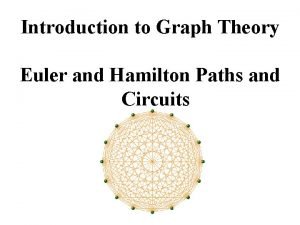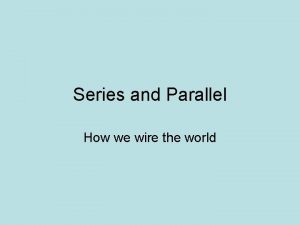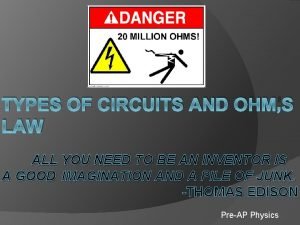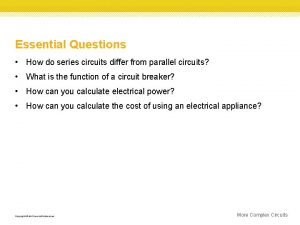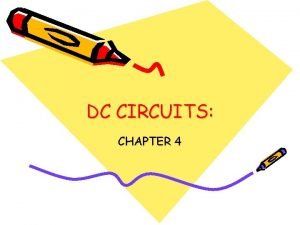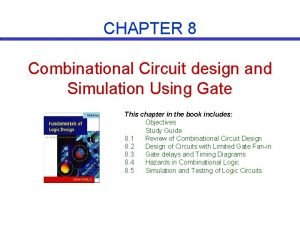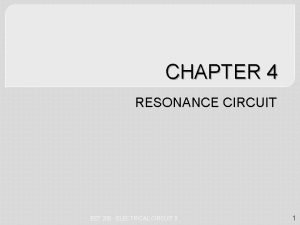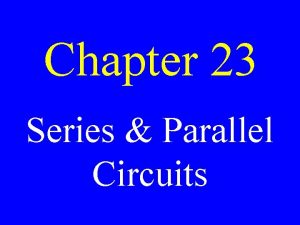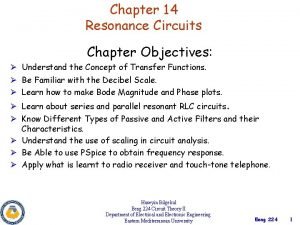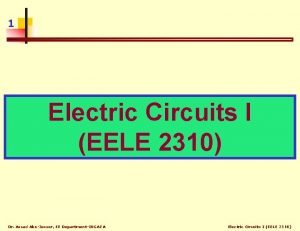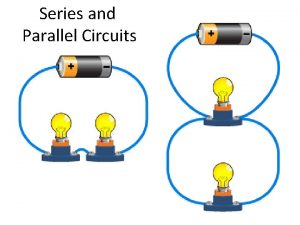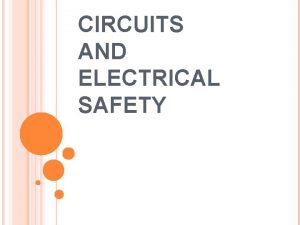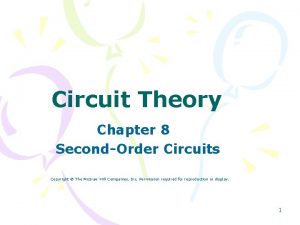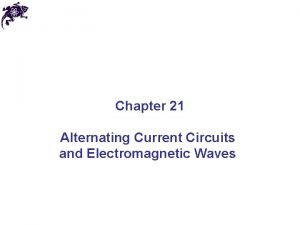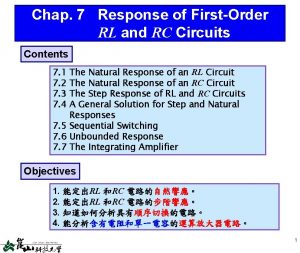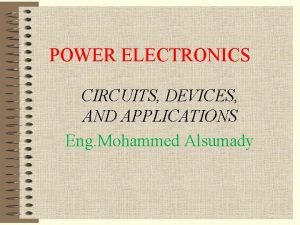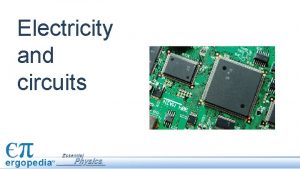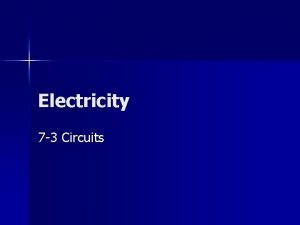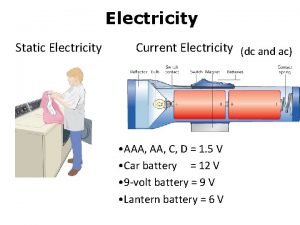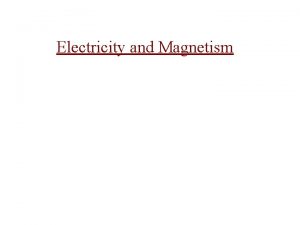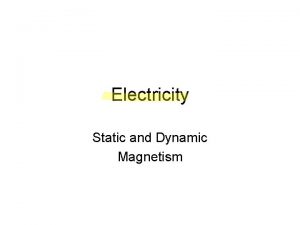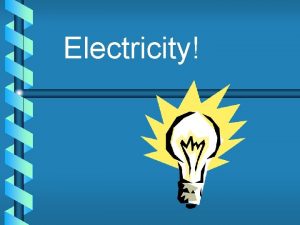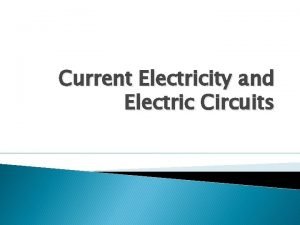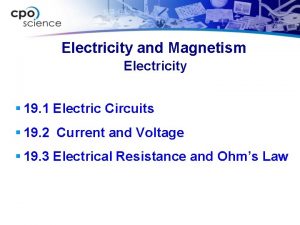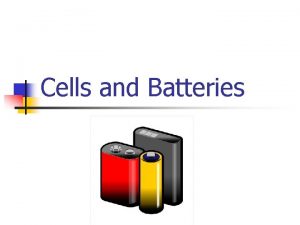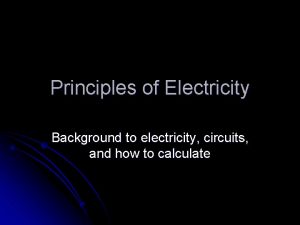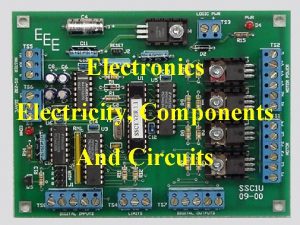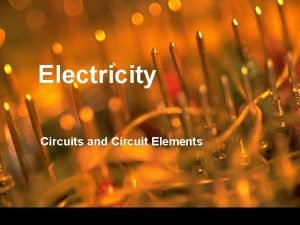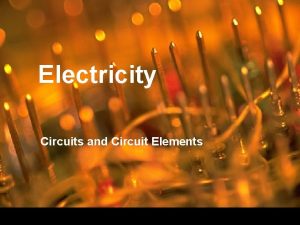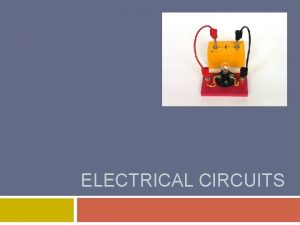CIRCUITS AND ELECTRICITY UNIT ATOM An atom is


































- Slides: 34

CIRCUITS AND ELECTRICITY UNIT

ATOM • An atom is the smallest particle characterizing an element. All matter in the universe is made up of a combination of different atoms. Atoms are made up of protons, neutrons and electrons.

ELECTRICAL CHARGE • An electrical charge is produced when an atom loses or gains an electron. When there are more electrons than protons, the charge is negative. When there are fewer electrons than protons, the charge is positive. The unit of electrical charge is the coulomb (symbol: C).

ELECTRICAL CURRENT • An electrical current is the movement of negative electrical charges (electrons) through a conductor (electrical wire, metal foil, etc. ). In an electrical circuit, the current flows from the point where the electrical potential is highest to the point where it is lowest.

ELECTRICAL CIRCUIT • An electrical circuit is the complete loop through which an electrical current flows. It is made up of a series of electrical components and conductors (e. g. , batteries, electrical wires, light bulbs, etc. ). The current only flows in an electrical circuit when the path is completely closed, forming a loop.

TYPES OF ELECTRICAL CIRCUIT • There are two types of electrical circuit, parallel circuits and series circuits. Parallel circuits provide several different paths for the electrical current. Series circuits force the current through a single path; in other words, the electricity flows through all the electrical components of a series circuit one after the other.

SERIES CIRCUITS • Components connected in series are connected along a single conductive path, so the same current flows through all of the components but voltage is dropped (lost) across each of the resistances. • In a series circuit, the sum of the voltages consumed by each individual resistance is equal to the source voltage. • In a series circuit, the current that flows through each of the components is the same, and the voltage across the circuit is the sum of the individual voltage drops across each component.

PARALLEL CIRCUITS • Components connected in parallel are connected along multiple paths so that the current can split up; the same voltage is applied to each component. • In a parallel circuit, the voltage across each of the components is the same, and the total current is the sum of the currents flowing through each component.

CONDUCTORS OF ELECTRICITY • Conductors are bodies or materials that allow an electrical current to pass through them. Copper, aluminum, brass, zinc, iron and pewter are examples of metal that conduct electricity well. Salt water is also a good conductor.

• Insulators, such as wood and plastic, are materials that do not easily transmit heat, cold or electricity. Electrical wires are covered with an insulator to prevent electrical shocks and short circuits that could cause fires. INSULATOR

RESISTANCE • Resistance is the part of an electrical circuit that resists the flow of electricity (for example, by transforming it into heat or light, as in a light bulb or a buzzer). In an electrical circuit, the presence of a resistor limits the current and prevents damage related to short circuits. The unit used to measure resistance is the ohm (symbol: Ω).

AMPERE • Ampere The ampere (symbol: A) is the unit used to measure current intensity.

VOLTAGE • Voltage (symbol: V) is the unit used to measure electrical tension, also called “difference of electrical potential. ”

SHORT CIRCUIT • A short circuit occurs when two live (i. e. , carrying current) conductors accidentally come into contact, either directly or through a conducting object (e. g. , when the blade of an electric lawn mower cuts the electrical wire). When this happens, the current can flow with very little restriction because the resistance of the loop formed by the two conductors is very weak. The high amount of current heats up the wires and can cause a fire. Fuses and circuit breakers detect unusually high currents and break the circuit, which helps to prevent fires.

• Batteries are reserves of chemical energy that can be transformed into electrical energy. Small electric cells (commonly called batteries, as in AA batteries) are examples of simple batteries for everyday use. BATTERY

PEOPLE • Thomas Alva Edison (1847 -1931), a U. S. inventor who designed the first electric light bulb. He also invented many other devices, including the phonograph, ancestor of the gramophone. • Alessandro Volta (1745 -1827), an Italian physicist, invented the first electric battery.

BUILDING OUR CIRCUIT

CLASSIFYING RESISTORS

BASIC PARTS OF A CIRCUIT • Breadboard

WHY USE BREADBOARDS? • An electronics breadboard is actually referring to a solderless breadboard. These are great units for making temporary circuits and prototyping, and they require absolutely no soldering. • Prototyping is the process of testing out an idea by creating a preliminary model from which other forms are developed or copied, and it is one of the most common uses for breadboards. • For those new to electronics and circuits, breadboards are often the best place to start. That is the real beauty of breadboards--they can house both the simplest circuit as well as very complex circuits.

BASIC PARTS OF A CIRCUIT • Battery

WHY USE A BATTERY? • A battery is a source of energy which provides a push - a voltage - of energy to get the current flowing in a circuit.

BASIC PARTS OF A CIRCUIT • Battery Snap

WHY USE A BATTERY SNAP? • As you can see from this photo, the battery snap is designed to snap onto the leads on the terminal end of any standard 9 Vbattery. These battery straps have two leads, a red "positive" wire and a black "negative" wire.

BASIC PARTS OF A CIRCUIT • Multimeter

WHY USE A MULTIMETER? • Multimeters are absolutely necessary for any type of electrical work. From installing a ceiling fan to changing a junction box, using a multimeter helps determine if wires are hot or not (and so much more). Multimeters are designed to measure three fundamental components of electrical energy: volts, amps and ohms.

BASIC PARTS OF A CIRCUIT • Resistor

WHY USE A RESISTOR? • The main function of resistors in a circuit is to control the flow of current to other components. Take an LED (light) for example. If too much current flows through an LED it is destroyed. So a resistor is used to limit the current.

BASIC PARTS OF A CIRCUIT • LED (Light emitting diode)

WHY USE AN LED? • LEDs are a particular type of diode that convert electrical energy into light. In fact, LED stands for "Light Emitting Diode. “ • In short, LEDs are like tiny lightbulbs. However, LEDs require a lot less power to light up by comparison. They're also more energy efficient, so they don't tend to get hot like conventional lightbulbs do

BASIC PARTS OF A CIRCUIT • Jumper Wires

WHY USE JUMPER WIRES? • Jumper wires are simply wires that have connector pins at each end, allowing them to be used to connect two points to each other without soldering. Jumper wires are typically used with breadboards and other prototyping tools in order to make it easy to change acircuit as needed.

BASIC PARTS OF A CIRCUIT • Switches

WHY USE SWITCHES IN A CIRCUIT? • A switch is a component which controls the open-ness or closed-ness of an electric circuit. They allow control over current flow in a circuit (without having to actually get in there and manually cut or splice the wires). Switches are critical components in any circuit which requires user interaction or control.
 Static electricity and current electricity
Static electricity and current electricity Static electricity and current electricity
Static electricity and current electricity Electricity and magnetism vocabulary
Electricity and magnetism vocabulary What is a parallel circuit in physics
What is a parallel circuit in physics Joshua's law unit 10 lesson 1
Joshua's law unit 10 lesson 1 Unit 6 review questions
Unit 6 review questions The structure of the atom section 2 defining the atom
The structure of the atom section 2 defining the atom Model atom democritus
Model atom democritus Euler
Euler Alexander hamilton
Alexander hamilton Pros and cons of parallel and series circuits
Pros and cons of parallel and series circuits Virtual circuit and datagram network
Virtual circuit and datagram network Types of circuits and ohm's law ch 7.1 answers
Types of circuits and ohm's law ch 7.1 answers What is a incomplete circuit
What is a incomplete circuit Difference between parallel and series connection
Difference between parallel and series connection How do series and parallel circuits differ
How do series and parallel circuits differ Equivalent inductance
Equivalent inductance Combinational circuit design
Combinational circuit design Series and parallel circuits
Series and parallel circuits Chapter 35 electric circuits answers
Chapter 35 electric circuits answers Chapter 23 series and parallel circuits study guide answers
Chapter 23 series and parallel circuits study guide answers Parallel resonance
Parallel resonance Lesson 8 comparing series and parallel rlc circuits
Lesson 8 comparing series and parallel rlc circuits Equivalent resistance of a parallel circuit
Equivalent resistance of a parallel circuit Electric circuits nilsson
Electric circuits nilsson Bill nye static electricity worksheet
Bill nye static electricity worksheet Venn diagram of series circuit and parallel circuit
Venn diagram of series circuit and parallel circuit Venn diagram series and parallel circuits
Venn diagram series and parallel circuits Lesson 8: comparing series and parallel rlc circuits
Lesson 8: comparing series and parallel rlc circuits Alternating current circuits and electromagnetic waves
Alternating current circuits and electromagnetic waves Rl step response
Rl step response 2057 octal to decimal
2057 octal to decimal Binary systems and logic circuits
Binary systems and logic circuits Power electronics circuits devices and applications
Power electronics circuits devices and applications Moore machine and mealy machine
Moore machine and mealy machine









